Anthozoa
| Anthozoa Temporal range: Late Ediacaran to recent
| |
|---|---|

| |
| Coral outcrop on the Great Barrier Reef | |
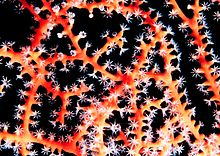
| |
| Gorgonian with polyps expanded | |
| Scientific classification | |
| Domain: | Eukaryota |
| Kingdom: | Animalia |
| Phylum: | Cnidaria |
| Subphylum: | Anthozoa Ehrenberg, 1834 |
| Subclasses | |
| |
Anthozoa is a class of marine invertebrates which includes the sea anemones, stony corals and soft corals. Adult anthozoans are almost all attached to the seabed, while their larvae can disperse as part of the plankton. The basic unit of the adult is the polyp; this consists of a cylindrical column topped by a disc with a central mouth surrounded by tentacles. Sea anemones are mostly solitary, but the majority of corals are colonial, being formed by the budding of new polyps from an original, founding individual. Colonies are strengthened by calcium carbonate and other materials and take various massive, plate-like, bushy or leafy forms.
Anthozoa is included within the phylum
Anthozoans are carnivores, catching prey with their tentacles. Many species supplement their energy needs by making use of photosynthetic single-celled algae that live within their tissues. These species live in shallow water and many are reef-builders. Other species lack the zooxanthellae and, having no need for well-lit areas, typically live in deep-water locations.
Unlike other members of this phylum, anthozoans do not have a
Diversity

The name "Anthozoa" comes from the Greek words άνθος (ánthos; "flower") and ζώα (zóa; "animals"), hence ανθόζωα (anthozoa) = "flower animals", a reference to the floral appearance of their perennial polyp stage.[1]
Anthozoans are exclusively marine, and include
Phylogeny
Anthozoa is subdivided into three subclasses:
| Anthozoa |
| |||||||||||||||||||||||||||||||||||||||
Historically, the "Ceriantipatharia" was thought to be a separate subclass but, of the two
Hexacorallia includes
Classification according to the World Register of Marine Species:[8]
- subclass Hexacorallia
- order Actiniaria— sea anemones
- order Antipatharia— black coral
- order Corallimorpharia — corallimorphs
- order Rugosa †
- order Scleractinia — stony corals
- order Zoantharia — zoanthids
- order
- subclass Octocorallia
- order Alcyonacea — soft corals and gorgonians
- order Helioporacea — blue corals
- order Pennatulacea— pennatules, sea feathers, sea pens, sea pansies
- subclass Ceriantharia— ceriantharians, tube-dwelling anemones
- order Penicillaria
- order Spirularia
- order
- Anthozoa incertae sedis
- genus Aiptasiodes
- order Auloporida †
- genus Sarcinula †
Octocorallia comprises the sea pens (
Ceriantharia comprises the related tube-dwelling anemones. Tube-dwelling anemones or cerianthids look very similar to sea anemones, but belong to an entirely different subclass of anthozoans. They are solitary, living buried in soft sediments. Tube anemones live and can withdraw into tubes, which are made of a fibrous material, which is made from secreted mucus and threads of nematocyst-like organelles, known as ptychocysts.[2]
| Major anthozoan taxa | |||||
|---|---|---|---|---|---|
| Subclass | Order | Image | Example | Characteristics | Distribution |
| Hexacorallia | Actiniaria Sea anemones |
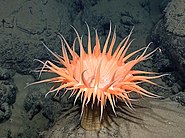 |
Actinostola sp. | Mostly large, solitary polyps anchored to hard substrates. Often colourful. Zooxanthellate or azooxanthellate.[2] | Worldwide in shallow and deep water, with greatest diversity in tropics.[2] |
| Hexacorallia | Antipatharia Black coral |
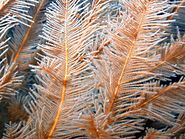 |
Plumapathes pennacea | Bushy colonies with slender branches. Axial skeleton of dark-coloured thorny branches strengthened by a unique, non-collagen protein. Azooxanthellate.[2] | On vertical rock faces of reefs, or in deep water.[2] |
| Hexacorallia | Corallimorpharia Corallimorphs or coral anemones |
 |
Discosoma sp. | Large, solitary polyps similar to sea anemones, but with stumpy columns and large oral discs with many short tentacles. Catch large prey and some species zooxanthellate.[2] | On coral reefs, mostly tropical.[2] |
| Hexacorallia | Rugosa Extinct |
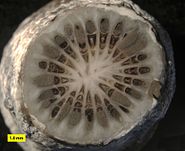 |
Stereolasma rectum | Extinct order abundant in Middle Late Permian. Solitary or colonial, with a skeleton formed of calcite. Septa develop in multiples of four.[9] |
Widespread. |
| Hexacorallia | Scleractinia Stony corals or hard corals |
 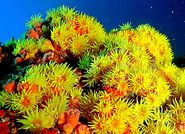 |
Tubastraea coccinea |
Solitary or colonial corals in a vast assortment of sizes and shapes, the stony skeleton being composed of aragonite. Septa develop in multiples of six.[9] Zooxanthellate or azooxanthellate.[2] | Shallow and deep water habitats worldwide, the greatest diversity being in tropical seas.[2] |
| Hexacorallia | Zoantharia Zoanthids |
 |
"Dragon eye" coral Zoanthus sp. |
Small, mostly colonial species joined by coensarc or stolons. No hard skeleton but some incorporate solid matter into fleshy periderm.[2] | Mostly tropical, reef-dwelling species.[2] |
| Octocorallia | Alcyonacea Soft corals and gorgonians |
 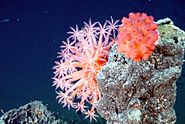 |
Alcyonium digitatum Mushroom corals |
Colonial and diverse, with polyps almost completely embedded in thick fleshy coenosarc. Gorgonians have a horny skeleton. Zooxanthellate or azooxanthellate.[2] | Worldwide, mostly in tropical and subtropical waters, associated with coral reefs and in deep sea.[2] |
| Octocorallia | Helioporacea Blue corals |
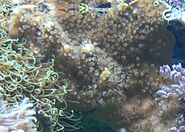 |
Heliopora coerulea |
Octocorals with a massive skeleton composed of aragonite secreted by underside of coenosarc. Zooxanthellate.[10] | Heliopora coerulea is IndoPacific; other species are from the Atlantic and Madagascar.[11] |
| Octocorallia | Pennatulacea Sea pens, sea feathers and sea pansies |
 |
Ptilosarcus gurneyi | Colonial species taking pinnate, radial or club-like forms. Main axis is a single enlarged and elongated polyp. Has several types of specialist polyp. Azooxanthellate.[10] | Worldwide, from lower tidal to 6,000 m (20,000 ft)[12] |
| Ceriantharia | Penicillaria Tube-dwelling anemones |
 |
Arachnanthus sarsi | Solitary individuals with two rings of tentacles living in fibrous tubes in soft sediment. Distinguished from Spirularia by anatomy and cnidom.[13] | In soft sediment, worldwide.[14] |
| Ceriantharia | Spirularia Tube-dwelling anemones |
 |
Cerianthus filiformis | Solitary individuals with two rings of tentacles living in fibrous tubes. Distinguished from Penicillaria by anatomy and cnidom.[13] | In soft sediment, worldwide.[14] |
Anatomy
The basic body form of an anthozoan is the polyp. This consists of a tubular column topped by a flattened area, the oral disc, with a central mouth; a whorl of tentacles surrounds the mouth. In solitary individuals, the base of the polyp is the foot or pedal disc, which adheres to the substrate, while in colonial polyps, the base links to other polyps in the colony.[2]
The mouth leads into a tubular pharynx which descends for some distance into the body before opening into the coelenteron, otherwise known as the gastrovascular cavity, that occupies the interior of the body. Internal tensions pull the mouth into a slit-shape, and the ends of the slit lead into two grooves in the pharynx wall called siphonoglyphs. The coelenteron is subdivided by a number of vertical partitions, known as mesenteries or septa. Some of these extend from the body wall as far as the pharynx and are known as "complete septa" while others do not extend so far and are "incomplete". The septa also attach to the oral and pedal discs.[2]
The body wall consists of an epidermal layer, a jellylike
The tentacles are armed with nematocysts, venom-containing cells which can be fired harpoon-fashion to snare and subdue prey. These need to be replaced after firing, a process that takes about forty-eight hours. Some sea anemones have a circle of acrorhagi outside the tentacles; these long projections are armed with nematocysts and act as weapons. Another form of weapon is the similarly armed acontia (threadlike defensive organs) which can be extruded through apertures in the column wall. Some stony corals employ nematocyst-laden "sweeper tentacles" as a defence against the intrusion of other individuals.[2]
Many anthozoans are colonial and consist of multiple polyps with a common origin joined by living material. The simplest arrangement is where a stolon runs along the substrate in a two dimensional lattice with polyps budding off at intervals. Alternatively, polyps may bud off from a sheet of living tissue, the coenosarc, which joins the polyps and anchors the colony to the substrate. The coenosarc may consist of a thin membrane from which the polyps project, as in most stony corals, or a thick fleshy mass in which the polyps are immersed apart from their oral discs, as in the soft corals.[2]
The skeleton of a stony coral in the order Scleractinia is secreted by the epidermis of the lower part of the polyp; this forms a corallite, a cup-shaped hollow made of calcium carbonate, in which the polyp sits. In colonial corals, following growth of the polyp by budding, new corallites are formed, with the surface of the skeleton being covered by a layer of coenosarc. These colonies adopt a range of massive, branching, leaf-like and encrusting forms.[15] Soft corals in the subclass Octocorallia are also colonial and have a skeleton formed of mesogloeal tissue, often reinforced with calcareous spicules or horny material, and some have rod-like supports internally.[16] Other anthozoans, such as sea anemones, are naked; these rely on a hydrostatic skeleton for support. Some of these species have a sticky epidermis to which sand grains and shell fragments adhere, and zoanthids incorporate these substances into their mesogloea.[2]
Biology
Most anthozoans are opportunistic predators, catching prey which drifts within reach of their tentacles. The prey is secured with the help of sticky mucus, spirocysts (non-venomous harpoon cells) and nematocysts (venomous harpoon cells). The tentacles then bend to push larger prey into the mouth, while smaller, plankton-size prey, is moved by cilia to the tip of the tentacles which are then inserted into the mouth. The mouth can stretch to accommodate large items, and in some species, the lips may extend to help receive the prey. The pharynx then grasps the prey, which is mixed with mucus and slowly swallowed by peristalsis and ciliary action. When the food reaches the coelenteron, extracellular digestion is initiated by the discharge of the septa-based nematocysts and the release of enzymes. The partially digested food fragments are circulated in the coelenteron by cilia, and from here they are taken up by phagocytosis by the gastrodermal cells that line the cavity.[2]
Most anthozoans supplement their predation by incorporating into their tissues certain unicellular, photosynthetic organisms known as

With longitudinal, transverse and radial muscles, polyps are able to elongate and shorten, bend and twist, inflate and deflate, and extend and contract their tentacles. Most polyps extend to feed and contract when disturbed, often invaginating their oral discs and tentacles into the column. Contraction is achieved by pumping fluid out of the coelenteron, and reflation by drawing it in, a task performed by the siphonoglyphs in the pharynx which are lined with beating cilia. Most anthozoans adhere to the substrate with their pedal discs but some are able to detach themselves and move about, while others burrow into the sediment. Movement may be a passive drifting with the currents or in the case of sea anemones, may involve creeping along a surface on their base.[2]
Gas exchange and excretion is accomplished by diffusion through the tentacles and internal and external body wall, aided by the movement of fluid being wafted along these surfaces by cilia. The sensory system consists of simple nerve nets in the gastrodermis and epidermis, but there are no specialised sense organs.[2]
Anthozoans exhibit great powers of regeneration; lost parts swiftly regrow and the sea anemone

Most anthozoans are unisexual but some stony corals are hermaphrodite. The germ cells originate in the endoderm and move to the gastrodermis where they differentiate. When mature, they are liberated into the coelenteron and thence to the open sea, with fertilisation being external.[2] To make fertilisation more likely, corals emit vast numbers of gametes, and many species synchronise their release in relation to the time of day and the phase of the moon.[22]
The zygote develops into a planula larva which swims by means of cilia and forms part of the plankton for a while before settling on the seabed and metamorphosing into a juvenile polyp. Some planulae contain yolky material and others incorporate zooxanthellae, and these adaptations enable these larvae to sustain themselves and disperse more widely.[2] The planulae of the stony coral Pocillopora damicornis, for example, have lipid-rich yolks and remain viable for as long as 100 days before needing to settle.[23]
Ecology
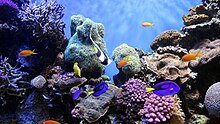
Coral reefs are some of the most biodiverse habitats on earth, supporting large numbers of species of corals, fish, molluscs, worms, arthropods, starfish, sea urchins, other invertebrates and algae. Because of the photosynthetic requirements of the corals, they are found in shallow waters, and many of these fringe land masses.[24] With a three-dimensional structure, coral reefs are very productive ecosystems; they provide food for their inhabitants, hiding places of various sizes to suit many organisms, perching places, barriers to large predators and solid structures on which to grow. They are used as breeding grounds and as nurseries by many species of pelagic fish, and they influence the productivity of the ocean for miles around.[25] Anthozoans prey on animals smaller than they are and are themselves eaten by such animals as fish, crabs, barnacles, snails and starfish. Their habitats are easily disturbed by outside factors which unbalance the ecosystem. In 1989, the invasive crown-of-thorns starfish (Acanthaster planci) caused havoc in American Samoa, killing 90% of the corals in the reefs.[26]
Corals that grow on reefs are called
Other fauna, such as
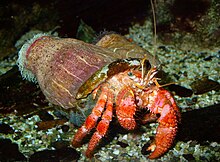
A number of sea anemone species are
Paleontology
Several extinct orders of corals from the Paleozoic era (~540–252 million years ago) are thought to be close to the ancestors of modern Scleractinia:[32][33]
- Numidiaphyllida †
- Kilbuchophyllida †
- Heterocorallia †
- Rugosa †
- Heliolitida †
- Tabulata †
- Cothoniida †
- Tabuloconida †
These are all corals and correspond to the
 | |
|
Timeline of the major coral fossil record and developments from 650 |
|
Interactions with humans
Coral reefs and shallow marine environments are threatened, not only by natural events and increased sea temperatures, but also by such man-made problems as pollution, sedimentation and destructive fishing practices. Pollution may be the result of run-off from the land of sewage, agricultural products, fuel or chemicals. These may directly kill or injure marine life, or may encourage the growth of algae that smother native species, or form algal blooms with wide-ranging effects. Oil spills at sea can contaminate reefs, and also affect the eggs and larva of marine life drifting near the surface.[36]
Corals are collected for the aquarium trade, and this may be done with little care for the long-term survival of the reef. Fishing among reefs is difficult and
Deep water coral habitats are also threatened by human activities, particularly by indiscriminate trawling. These ecosystems have been little studied, but in the perpetual darkness and cold temperatures, animals grow and mature slowly and there are relatively fewer fish worth catching than in the sunlit waters above. To what extent deep-water coral reefs provide a safe nursery area for juvenile fish has not been established, but they may be important for many cold-water species.[37]
References
- ^ "Anthozoa: Etymology". Fine Dictionary. Retrieved 25 June 2017.
- ^ ISBN 978-81-315-0104-7.)
{{cite book}}: CS1 maint: multiple names: authors list (link - )
- ^ ISBN 978-0-8138-2411-6.
- ^ PMID 24475157.
- ^ .
- PMID 7663762.
- ^ Hoeksema, Bert (2013). "Anthozoa". WoRMS. World Register of Marine Species. Retrieved 2015-04-24.
- ^ ISBN 978-0-674-02574-5.
- ^ ISBN 978-0-03-056747-6.
- ISBN 978-0-642-32210-4.
- PMID 21829500.
- ^ ISBN 978-3-319-31305-4.
- ^ ISBN 978-1-4020-2762-8.
- ^ "Corals: How do stony corals grow? What forms do they take?". National Oceanic and Atmospheric Administration. 25 March 2008. Retrieved 13 June 2017.
- ^ "Introduction to the Octocorallia". University of California Museum of Paleontology. Retrieved 13 June 2017.
- ^ "Contribution to the BUFUS Newsletter, Field excursion to Milne Bay Province - Papua New Guinea, Madl and Yip 2000". Archived from the original on 2020-05-11. Retrieved 2011-05-23.
- ISBN 978-0-520-23939-5.
- PMID 21676808.
- ISBN 978-3-319-31305-4.
- ^ Carefoot, Tom. "Learn about Sea Anemones and Relatives: Reproduction: Asexual". A Snail's Odyssey. Archived from the original on 6 June 2017. Retrieved 15 June 2017.
- ^ "Corals: How do corals reproduce?". National Oceanic and Atmospheric Administration. 25 March 2008. Retrieved 17 June 2017.
- S2CID 84571244.
- ^ "Corals: Importance of coral reefs". National Oceanic and Atmospheric Administration. 25 March 2008. Retrieved 17 June 2017.
- ISBN 978-3-642-80046-7.
- ^ "Corals: Natural Threats to Coral Reefs". National Oceanic and Atmospheric Administration. 25 March 2008. Retrieved 17 June 2017.
- ISBN 978-0-521-88485-3.
- ISBN 978-3-89356-033-2.
- ^ Agbayani, Eli. "Hippocampus bargibanti, Pygmy seahorse". FishBase. Retrieved 18 June 2017.
- ISBN 9780872495357.
- ^ ISBN 978-0-08-057945-0.
- )
- ^ Kotrc, Ben (2005). "Anthozoa: Subgroups". Fossil Groups. University of Bristol. Archived from the original on 2009-09-27. Retrieved 2007-04-10.
- UCMP. Retrieved 9 March 2020.
- USGS. Archived from the originalon 9 January 2009. Retrieved 9 March 2020.
- ^ a b "Corals: Anthropogenic threats to corals". National Oceanic and Atmospheric Administration. 25 March 2008. Retrieved 13 June 2017.
- ISBN 978-0-521-88485-3.



